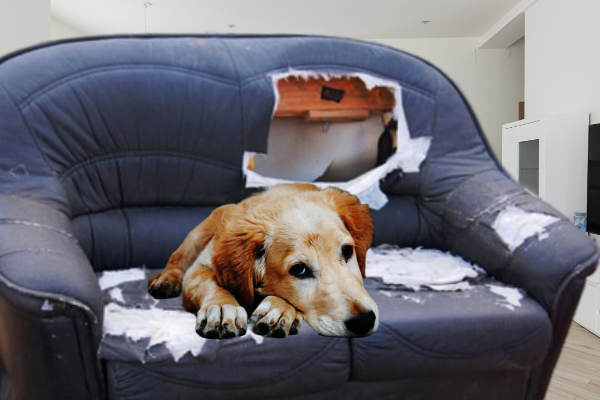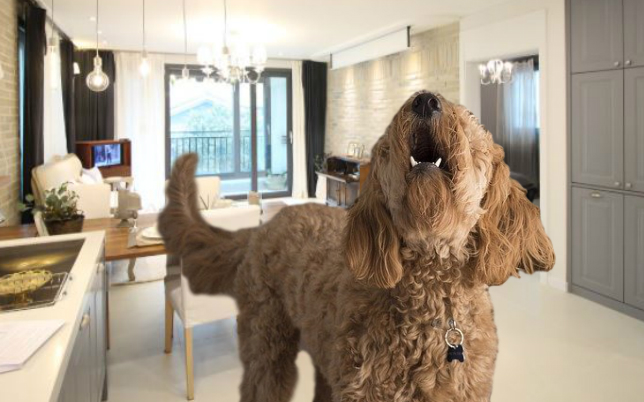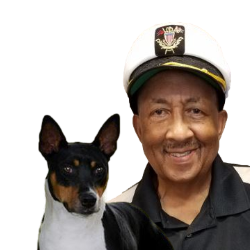The signs of anxiety in dogs post may contain affiliate links. Learn more on my Affiliate Disclosure page.
Understanding the signs of anxiety in dogs can help us better support and care for our beloved pets.
Do you ever wonder what your furry friend is thinking? Dogs have a way to communicate their feelings through body language.
From subtle cues like tail tucking and panting to more overt behaviors like restlessness and destructive chewing, these signs serve as their unique language that we can learn to decipher.
So, if you're ready to dive into the fascinating world of canine emotions, grab your detective hat and join us as we uncover the telltale signs of anxiety in dogs.
Decipher Signs Of Anxiety In Dogs
Understanding signs of anxiety in dogs is essential for any pet owner. While it may be challenging to decipher, dogs often display several signs when experiencing stress.
These signs can vary from excessive barking, destructive behavior, and even self-harm, like excessive licking or biting. It is important to note that these signs of anxiety in dogs can also indicate other underlying issues, such as boredom or physical discomfort.
One specific type of anxiety commonly observed in dogs is separation anxiety. A dog becomes stressed or anxious when separated from their owner or caregiver.
Signs of separation anxiety include excessive whining or howling, pacing, urinating or defecating indoors even if they are house-trained, and destructive behavior towards themselves or household items.
As responsible pet owners, we must pay attention to these signs and take appropriate action to help alleviate our furry friends' stress and improve their overall well-being.

Types Of Anxiety In Dogs
Anxiety issues are considered the most common mental health disorders in dogs. Like humans, dogs experience anxiety for various reasons, from environmental exposure to physical health conditions.
As a pet parent, you must know the different types of anxiety that can affect your four-legged friend following are the most common disorders:
1. Separation Anxiety
Separation anxiety is the most common type of anxiety disorder in dogs. If you leave your pet alone and no family members are around for a period of time, it can cause anxiety.
The intensity of the anxiety can vary—some dogs may become excessively vocal or destructive when left unsupervised. In contrast, others may show more subtle signs, such as shaking or hiding when feeling anxious
2. Noise Phobia
Noise phobia is an excessive fear of loud noises or thunderstorms. Dogs with noise phobia may exhibit signs of anxiety or stress in the form of panting, pacing, trembling, and hiding.
Fear of loud noises or fireworks. Dogs with noise phobia may exhibit signs of anxiety or stress in the form of panting, pacing, trembling, and hiding.

These anxiety symptoms can be challenging to manage, so working with a trained professional is essential to create an appropriate treatment plan.
3. Fear of Being Alone
Some dogs may become anxious if left alone for long periods. When left alone for too long, these dogs may start to become depressed and isolated because they are unable to form the bond and communication needed by their owners.
Common symptoms of this type of anxiety include excessive barking, destructive behavior, and pacing.
4. Fear of Men
Also known as "familiar mistrust," dogs who are afraid of men may aloofly observe them from a distance or become aggressive because they are uncomfortable or uncertain in their presence.
Dogs that experience fear of men are likely experiencing anxiety due to past experiences, such as being mistreated by people in their past.
5. Social Anxiety
Social anxiety is an overwhelming fear or uneasiness around other dogs or people. Dogs who experience social anxiety may also try and hide or flee from their environment.
Anxiety disorders can be challenging to diagnose and treat, so working with a professional to determine the best course of action for your pet is essential.
As a dog parent, it's up to you to get your puppy comfortable and remove their anxiety issues so that it will lead a happy and healthy life with the proper support and care.
Common Signs Of Anxiety In Dogs
Regarding our beloved furry companions, dog parents must be aware of the signs of anxiety in dogs.
One common sign is excessive barking or howling, mainly when the dog is left alone. Barking could indicate separation anxiety, often leading to destructive behavior as the dog tries to escape or cope with their distress.
Barking could indicate separation anxiety.

Another telltale sign is excessive panting and pacing. Dogs may pace back and forth, unable to settle down, and exhibit restlessness or an inability to relax.
Pay attention if your dog is excessively licking their paws or body as well - this can be a sign of anxiety, allergies, or skin irritations triggered by stress.
Dog parents must remember that every dog is unique and may exhibit different signs of anxiety.
Some dogs may develop obsessive-compulsive behaviors such as tail chasing or excessive self-grooming when anxious. Others might lose their appetite or experience digestive issues like diarrhea or vomiting.
By recognizing these signs, we can help alleviate our dogs' anxiety and provide them the care and support they need.
Implementing consistent routines also helps reduce anxiety in dogs. Establishing regular feeding times, exercise sessions, and playtime can give them a sense of predictability and security.
Causes Of Anxiety In Dogs
Causes of anxiety in dogs can vary greatly, and dog parents need to understand these underlying factors.
- One common cause is separation anxiety, when dogs become incredibly distressed when left alone. Separation from dog parents can attributed to stress when a dog's strong bond with its dog parent has a fear of abandonment.
- Another cause of anxiety in dogs is changes in their environment or routine. Dogs are creatures of habit, and disrupting their familiar surroundings can trigger unease and uncertainty.
- Additionally, past traumatic experiences can contribute to a dog's anxiety. Dogs who have been mistreated or neglected may develop fears related to specific situations or objects that remind them of their trauma.
- Pet parents must create a safe and nurturing environment for these dogs, allowing them time to heal and build trust.
- Furthermore, genetics may affect a dog's predisposition towards anxiety. Some breeds are known to be more prone to anxious behavior due to genetic factors passed down through generations.
- Understanding your dog's breed characteristics can give you valuable insights into potential anxiety triggers they might face.
By recognizing these underlying causes of anxiety in dogs, pet owners can better support their furry companions' emotional well-being.
How To Help Signs Of Anxiety In Dogs
Several practical strategies can make a difference when it comes to helping signs of anxiety in dogs.
- One key aspect is establishing a routine and sticking to it. Dogs thrive on consistency, so providing them with a predictable schedule can help alleviate their anxiety.
- Another helpful tool is crate training, which provides dogs with a safe and secure space to retreat when feeling overwhelmed.
- In addition to these strategies, incorporating mental stimulation into your dog's daily routine can significantly reduce anxiety.
- Engaging in activities such as puzzle toys or interactive games keeps their minds occupied and helps tire them out physically, relieving restlessness and anxious behavior.
- Furthermore, implementing relaxation techniques such as massage or aromatherapy can have calming effects on anxious dogs.
It's important to note that each dog is unique and may respond differently to various techniques.
Tips For Preventing Anxiety In Dogs
One of the key ways to prevent anxiety in dogs:
- Regular exercise. Like humans, dogs need physical activity to release pent-up energy and reduce stress. A tired dog is a happy dog, so make sure to provide your furry friend with plenty of opportunities for exercise.
- Activities could include daily walks, interactive play sessions, or even training exercises that stimulate their body and mind.
- Another effective strategy is to create a calming environment at home. Dogs are sensitive creatures and can easily get stressed out by loud noises or chaotic surroundings.
- Try to provide them with a safe space to retreat when overwhelmed. It could be as simple as setting up a cozy corner with their bed and favorite toys or investing in calming products like pheromone diffusers or soothing music designed for dogs.
- Additionally, establishing a routine can go a long way in preventing anxiety in dogs. Dogs thrive on predictability; knowing what to expect daily helps them feel secure.
- Make sure you have set times for feeding, walking, playtime, and rest so that your dog knows what's coming next. Consistency provides comfort and helps alleviate anxiety caused by uncertainty.
By incorporating these tips into your dog's life, you can help prevent anxiety and create an environment where they feel calm, secure, and happy.
Home Remedies For Anxiety In Dogs
Separation anxiety can be difficult for pet owners and their beloved dogs. A dog parent should always seek professional help in severe cases.
Home remedies help alleviate this distressing condition.
- One solution is the use of essential oils. With its soothing properties, lavender oil can create a calming environment for your furry friend while you're away.
- Apply a few drops to a diffuser, combine it with some carrier oil, and apply it to their bedding before leaving.
Soothing Home Environment: ThunderEssence Dog Calming Essential Oils spray is perfect for creating a peaceful atmosphere at home. Whether you're hosting guests or dealing with fireworks outside, just a few sprays of this natural blend will help calm your pup, promoting relaxation and reducing unwanted behaviors caused by environmental stressors.
Natural Stress Relief: Nexon Botanics Stress Relief Essential Oil is specially formulated to calm and relax dogs during stressful situations, such as thunderstorms or vet visits. Made with 100% pure and natural ingredients, it provides a safe and effective way to soothe your furry friend's nerves without any harmful chemicals or additives.
Other Anxiety Calming Home Remedy Products
Calm Your Canine Companion: The Peaceful Pup's Dog Anxiety & Stress Relief Roll-On helps soothe and relax anxious dogs, giving them a greater sense of calm and tranquility. Say goodbye to nervous behaviors like excessive barking, pacing, and destructive chewing - and hello to a happier, more peaceful pup!
K9 Training Institute Free Workshop
The K9 Training Institute offers a free workshop where you can learn firsthand their effective training methods.
The Free Workshop emphasizes building a solid bond between you and your pup. They explain how to apply positive reinforcement techniques that make learning enjoyable for dogs and their owners.
Does your dog tug on its leash, bark constantly, and won't come when called? Sign Up and get the FREE Obedience Training Workshop Now!
Seek Professional Help For Signs Of Anxiety In Dogs
Recognizing the signs of anxiety in dogs is essential for their well-being, but knowing when to seek professional help is equally important. Excessive stress can lead to detrimental effects on their physical and mental health.
- One red flag to watch out for is separation anxiety, which often manifests as destructive behavior when the dog is left alone. If your furry friend consistently destroys furniture or belongings when you are not around, it may be time to consult a professional.
- Another sign indicating the need for professional assistance is if your dog's anxiety begins interfering with their daily activities. Dogs experiencing severe anxiety may refuse to eat or exercise regularly due to fear or nervousness.
This marked change in behavior could indicate that they require specialized attention and treatment from a trained animal behaviorist or veterinarian who can help diagnose and develop an appropriate management plan.
Remember, seeking professional help ensures that your beloved pet receives the best care possible and enables you to navigate through any uncertainties about their emotional well-being.













